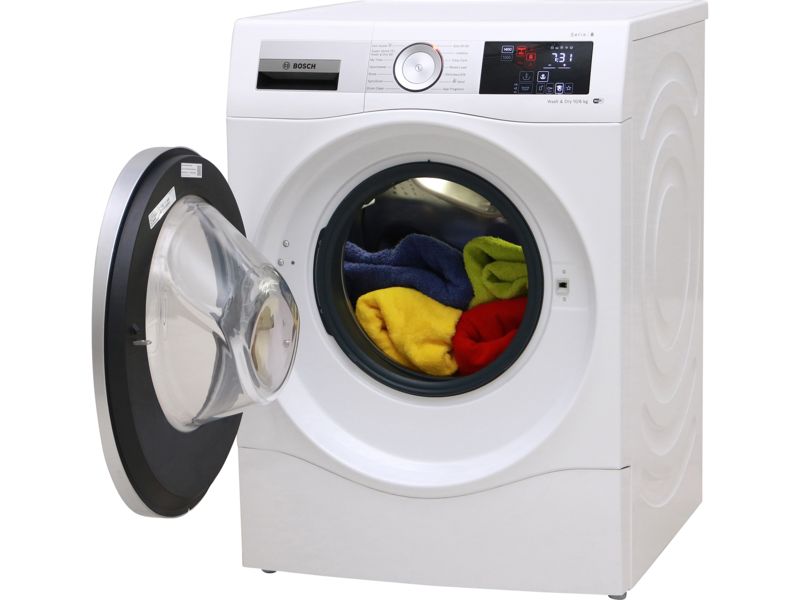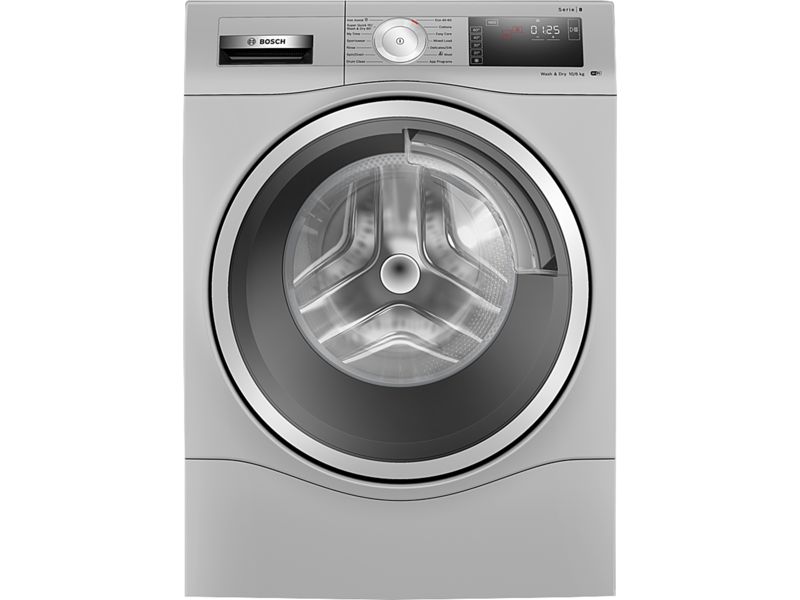How to buy the best integrated washer-dryer

But before you commit to an integrated washer-dryer, there are a few things to consider.
In this advice guide you’ll find out:
Head over to our integrated washer-dryer reviews to find the built in machines that scored tops for cleaning and drying in our tests.
What is an integrated washer-dryer?
An integrated washer-dryer is one that is integrated into your kitchen cabinets. It can wash and dry and is built in between units with a door covering the front. The benefit of this is that until it's switched on and you can hear it going round, you really don't know that it's there.
Integrated washer-dryers are sometimes referred to as built-in, and you might also have heard of semi-integrated washer-dryers. They're all slightly different models.
Fully integrated
A fully integrated washer-dryer hides the whole washer-dryer unit from view. You can't see the washer-dryer in the picture below because it's completely hidden behind the kitchen units.
Semi-integrated
Buy a semi-integrated washer-dryer and you’ll still have a cupboard door covering the machine, but there will be a space at the top so you can still see the display panel – useful for things like knowing how long you have left on a wash cycle, for example.
Built-in
Often confused with ‘integrated’, but ‘built-in’ actually means a standard washer-dryer that fits under your units with no door over the machine – as pictured below. You don't need to buy an integrated washer-dryer if this is what you're looking for.
Go to our washer-dryer reviews to compare all of the washer-dryers we've tested at our lab.
Pros and cons of an integrated washer-dryer
Pros:
Reduces the cluttered look of having appliances in the kitchen.
Needs to be flush to your units, so you won't have a machine that protrudes out at the front – which is helpful if you have a narrow galley kitchen.
Cons:
There are fewer integrated washer-dryers around so you'll have less choice
They're more expensive to buy than freestanding models
- If you're not a handyperson you'll generally have to pay more to install an integrated washer-dryer than you would a freestanding model.
How much will an integrated washer-dryer cost?
You'll generally pay a premium if you go for an integrated washer-dryer over an equivalent spec freestanding machine.
With all washer-dryers it's difficult to find a model that excels at both the jobs it needs to do: washing and drying. But we've found some integrated washer-dryers that have impressed us enough to be named Best Buys.
Head over to our integrated washer-dryer reviews to find the best machine for your budget.
Will I have less choice by going integrated?
Yes. We don’t test nearly as many integrated washer-dryers as we do freestanding washer-dryers. This is because there aren’t as many on the market.
If you have a large family and do a lot of washing, you'll find your choice is even more limited. This is because integrated washer-dryers have to be smaller and more compact as they need to fit into smaller spaces than other washers and dryers. This means they are less likely to be able to handle to volume or bulk of washing that a family or larger household will produce.
The largest load capacity integrated washer-dryer we currently have in our reviews at the time of writing holds 9kg. Most of the models we've recently tested have a 7kg load capacity. This is still enough to fit in most items you'll need to wash, but big duvets and bulky items might be a struggle.
How wide is an integrated washer-dryer?
Most integrated washer-dryers tend to be the same size. There is some variation, but the most common dimensions are a height of 82cm, a width of 60cm, and a depth of 56cm. If you stick with this size then you should be able to find a replacement quite easily should you need to.
Make sure you measure up before you buy
As there can be some variation in size, before you buy an integrated washer-dryer, it's vital to make sure it is going to fit in the space you have designated for it:
- Check all the measurements of your prospective washer-dryer against the space you will put it in, including the height, width and depth so they you ensure that it fits.
- Make sure you account for any pipes or hoses that will take up space behind the machine as this will take up extra room behind the machine.
- Most washer-dryers are condensers, but if it's a vented model then you'll need to consider where the vent will be and how this will impact fitting it.
- Check that the bottom of your machine will fit behind any plinth or kickboard that you have at the bottom of your kitchen unit. These are often recessed your washer dryer will need to fit behind it.
Consider where your washer-dryer is sitting
If you're having a kitchen makeover and are considering where your machine is going to go, bear in mind that the floor the washer-dryer (or any washing appliance) will sit on is going to need to be sturdy and solid.
Having a washing machine full of washing and water on your floor is about the same as having a person jumping heavily up and down on your floor. And while your floor might be able to take the abuse, the machine will certainly be noisier. Small imbalances can also cause the machine to develop a fault.
Fitting your integrated washer-dryer
You can either fit an integrated washer-dryer yourself or, if DIY isn't your bag, big white good retailers, such as AO.com and Currys can do the fit for you. Whether using a pro or doing it yourself, before you begin fitting, check that:
- the plinth (or kick board) can be removed and doesn’t need adjustments for your new washer-dryer.
- the kitchen unit door you'll be attaching to the integrated washer-dryer is in good condition.
- you have the fittings you need to attach it to the new machine (these usually come in a bag with the delivery).
- the power cord from the washer-dryer will reach to the power supply.
- your washer-dryer will be able to reach your home’s water connection and drain pipes.
Fitting your washer-dryer yourself
If your washer-dryer will fit neatly into your kitchen and will sit level on your floor, then it will be fairly easy to fit yourself.
You might, however, need two people to handle the washer-dryer as they are heavy, bulky and often have sharp edges.
If it's not being delivered into your kitchen, make sure you have a plan for getting it to where it's going to live; measure any halls or tight spaces it needs to pass through. A platform with casters may be useful to move it into place.
You’ll also need to slide it into space without damaging your floor surfaces or scraping any of your cupboards. Plastic floor guides that you can buy for a couple of pounds online can be used on the bottom of your washer-dryer to prevent it from scratching your floor and to help get it into place easier.
Getting a professional to fit your washer-dryer
Many retailers will offer an installation service with purchase of an appliance. For example, John Lewis offers an installation service for £90. This service includes the connection of the washer-dryer to electricity, water and waste water within one metre of the appliance, as well as the fitting of the door and removal of all packaging.
If you add up all the time and energy you’ll save by having a professional deal with installation, it could be good value.
In addition, if your washer-dryer doesn't fit perfectly you might want to call in an expert:
- If your washer-dryer is a bit smaller than the space you need to fit it in, this could present a challenge. You might need to prop your washer-dryer up on something to make it fit.
- If you elevate it on feet or a plinth this could make the washer-dryer prone to moving when in the spin cycle, which could wear on the door and the rest of the cupboard.
- Ideally the washer-dryer should sit sturdily on the floor, which might mean your cupboard door won’t fit properly to the washer-dryer if it’s not the right size.
If installation is going to be tricky because of a difference in size between the space for it in your kitchen and the machine, then its best to get a trusted expert to do the installation for you. They will be able to make sure the washer-dryer is stable and secure.
Installing your washer-dryer and your warranty
Always consult the manual for instructions on installation and operation. You might be tempted to jump right in, but you’ll be kicking yourself later if your machine breaks and you missed some crucial information.
And if you don’t install your washer-dryer according to the instructions, it’s possible that the warranty will be invalidated if the machine experiences issues in the future.



